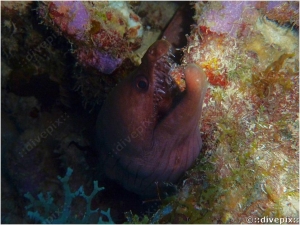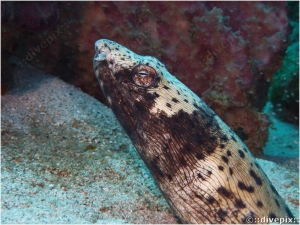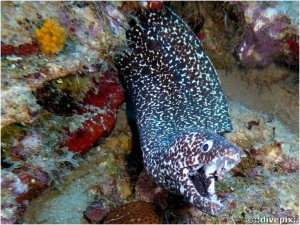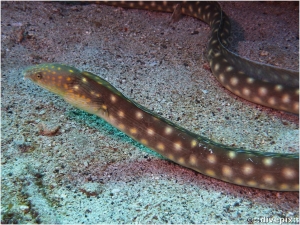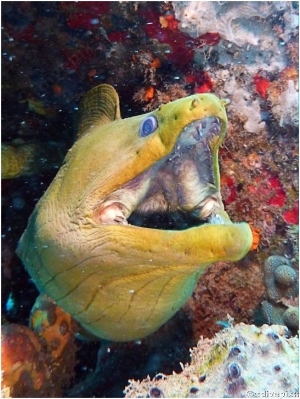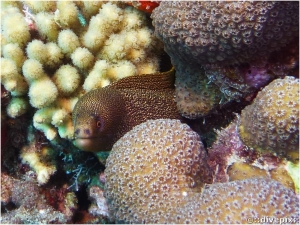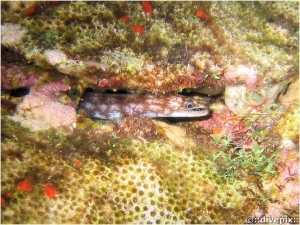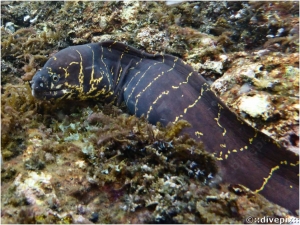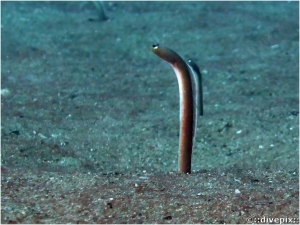




Eric H. Biass
vendredi, 14 décembre 2012 23:04
Spotted Snake Eel
| Aspect: | Grey-cream body with dark-stain leopard-like pattern. |
| Population: | Occasional. |
| Notable feature: | Wide "collar" around base of head. Horizontal slit eye. |
| Environment: | Sandy sea bottom in which it spends most of its time, head out and totally still. |
| Behaviour: | Relatively unscared. |
Publié dans
Anguilles
Tags:
vendredi, 14 décembre 2012 22:43
Spotted Moray
| Aspect: | Black body entirely covered in a random black-and-white stain pattern from snout to tail, including dorsal fin, the border of which remains black. |
| Population: | Ubiquitous, the second largest moray and the moray par excellence around Ilêts Pigeon, although they can almost disappear for a season! |
| Notable feature: | Like all morays, has no pectoral or pelvic fin. Dorsal fin turns around and under the flat tail end to effectively turn into an anal fin. Continuously widely opens and closes mouth, displaying an impressive, central, palatal row of sharp teeth. |
| Environment: | Rocky areas offering crevices and holes as habitats. Can often be seen swimming in daytime. |
| Behaviour: | Relatively unscared, can be approached very closely. |
Publié dans
Murènes
Tags:
vendredi, 14 décembre 2012 22:20
Sharptail Eel
| Aspect: | Thin, gray-brown, or outright light brown body with staggered fading edged brigh spots from head base to tail. Dorsal fin follow the same colour pattern as the body. |
| Population: | Common. |
| Notable feature: | Dots on head are smaller, denser and more markedly yellow - almost gold. |
| Environment: | Variable, but usually sandy or coral rubble seabed or in algae patches. Smaller specimens can even be seen near beaches in knee-deep waters. |
| Behaviour: | Relatively unscared, smaller specimens can easily be caught by hand. |
Publié dans
Anguilles
Tags:
vendredi, 14 décembre 2012 21:56
Green Moray
| Aspect: | Entirely green body. |
| Population: |
Scarce, and the largest moray around Ilêts Pigeon. There are two notable specimens, one around the Franjack wreck (with the scavenge pipe resting on the port gunwale a favourite domicile) and the other living in the various caves on the nothern side of the Pointe Barracuda ridge. NOTE: A new smaller specimen was spotted in a hole (see photo) at the base of the Pointe des Carangues "cliff" in January 2016. |
| Notable feature: | Parched skin, and like all morays, has no pectoral or pelvic fin. Dorsal fin turns around and under the flat tail end to effectively turn into an anal fin. Continuously opens and closes mouth, displaying an impressive, central, palatal row of sharp teeth. |
| Environment: | Hollow boxed areas in ship wrecks, or tight caves. |
| Behaviour: | Unscared, can be approached, but with great caution as it can inflict very serious and painful bites. Seldom seen swimming in open waters as it hunts at night. |
Publié dans
Murènes
Tags:
vendredi, 14 décembre 2012 21:43
Goldentail Moray
| Aspect: | Brown body, entirely covered in tiny yellow, gold-like, spots. Unlike other fishes, moray and ells do not have gills as such, but rather an exhaling hole that is difficulet to se on certain species like the Spotted Moray (q.v.), but perfectly visible on the Golden Tail Moray, roughly a mouth's length behind the crak of the lips (see red arrow on one of the photos below). |
| Population: | Very common, though nocturnal and thus seldom seen swimming in open water. |
| Notable feature: | Like all morays, has no pectoral or pelvic fin. Dorsal fin turns around and under the flat tail end to effectively turn into an anal fin. Continuously opens and closes mouth, displaying an impressive, central, palatal row of sharp teeth. |
| Environment: | Rocky areas offering crevices and holes as habitats. |
| Behaviour: | Relatively unscared, can be approached very closely. |
Publié dans
Murènes
Tags:
vendredi, 14 décembre 2012 21:30
Chestnut Moray
| Aspect: | Light brown upper body entirely covered in white blotches from snout to tail, including dorsal fin, though belly remains light coloured. |
| Population: | Common, but at 28 cm, is probably the smallest moray around Ilets Pigeon. |
| Notable feature: | Like all morays, has no pectoral or pelvic fin. Dorsal fin turns around and under the flat tail end to effectively turn into an anal fin. A distinguishible feature is its incapacity to keep the side of its jaws sealed. |
| Environment: | Rocky areas offering crevices and holes as habitats. A night-time species, ralrely seen swiming in open waters during the day. |
| Behaviour: | Relatively unscared, can be approached very closely. |
Publié dans
Murènes
Tags:
vendredi, 14 décembre 2012 21:18
Chain Moray
| Aspect: | Dark brown body entirely covered in a subtle pattern of irregular bright yellow chain links. |
| Population: | Occasional |
| Notable feature: | Like all morays, has no scales, pectoral or pelvic fin. Dorsal fin turns around and under the flat tail tip to effectively turn into an anal fin. Continuously opens and closes mouth. |
| Environment: | Rocky areas offering crevices and holes as habitats. |
| Behaviour: | Relatively unscared, can be approached very closely. |
Publié dans
Murènes
Tags:
vendredi, 14 décembre 2012 19:43
Brown Garden Eel
| Aspect: | Finger-thin brown body with paler underbelly. Translucent body-long dorsal fin. |
| Population: | Very common, lives in large colonies. |
| Notable feature: | Stands vertically out of its burrow, head curved down, catching the passing plankton. |
| Environment: | On barren, deep sandy sea-bottom at depths of 20 to 40 metres. |
| Behaviour: | Extremely wary, suddenly sinks into its burrow if approached too closely. |
Publié dans
Anguilles
Tags:
vendredi, 14 décembre 2012 18:44
Yellow Goatfish
| Aspect: | Elongated pale silver/white body with bright yellow ventreline line running from behind the eye to the tail. Deep V-cut tail is bright yellow. Other fins are usualy yellow although can remain white. |
| Population: | Common, often in groups or schools. |
| Notable feature: | Long chin barbel resembling a goat's beard, hence vernacular name. Uses barbels to dig sand for food. |
| Environment: | Near sandy bottom. |
| Behaviour: | Easily approched, will actually come close to a hand gently digging into the sand. |
Publié dans
Mullidés
Tags:



